Colomba Pasquale (Easter Dove Bread)
One of Italy's best-known traditional Easter breads
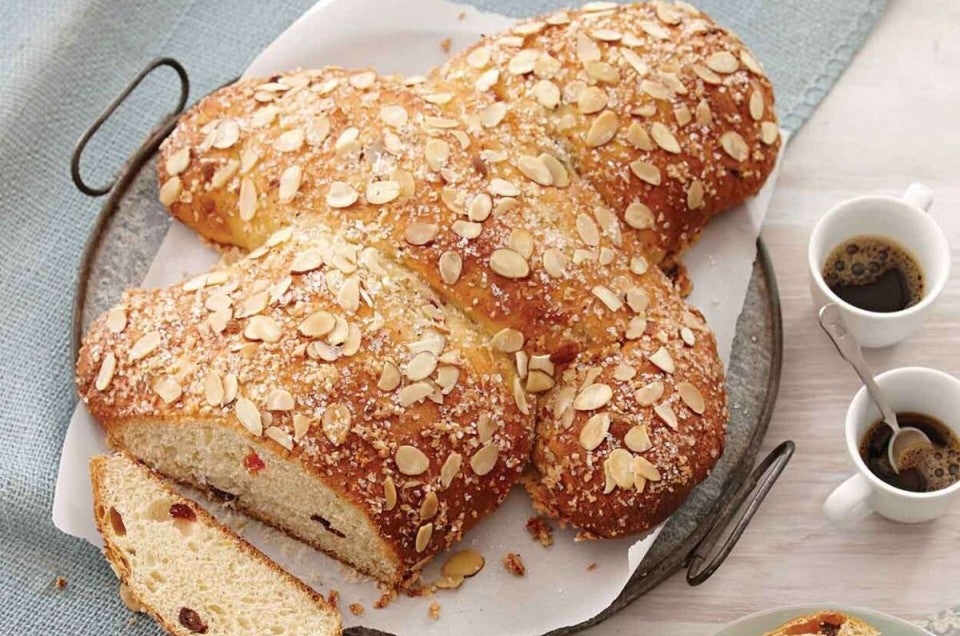

While Italy offers many traditional Easter breads, the best-known by far is Colomba Pasquale – Easter Dove Bread – a native of Lombardy in the north, but available everywhere when Easter rolls around.
Even in America one can find these panettone-like breads around the Easter holidays, especially in Italian bakeries.
The only challenge is, these "doves" look about as much like a bird as I look like – hmmm, how about the winner of the Hawaii Ironman Triathlon?
In other words - the resemblance is scanty at best.
There are dove pans, both paper and metal, that are supposed to give this loaf a distinctive, dove-like shape. But even baking this bread in a shaped pan results in a wavy, misshapen cross, more blob than bird.
What's a bread artist to do?
Well, if you're like me, and can't stand fussing with your food – very little. Still, I found a fairly easy way to make this tasty sweet bread at least somewhat avian in appearance. And if I can "sculpt" this, you can, too.
OK, maybe it's not going to be the apple of anyone's eye.
But, so what? If you like panettone, you'll love "the dove."

The first thing we'll do is make an overnight starter. This gives the yeast a good jump start; and, with any long, slow rise, it helps develop the loaf's flavor.
Place the following ingredients in a bowl. It's handy to use the same bowl you'll use for tomorrow's dough.
1 cup King Arthur Unbleached All-Purpose Flour
1/2 cup cool water
1/8 teaspoon instant yeast
Stir together, cover the bowl, and leave it at room temperature for up to 15 hours or so.

The starter will become bubbly.
OK, we're going to skip ahead a few steps here. But stay with me: this is interesting.
Do you have trouble getting your high-sugar yeast breads to rise? Do they poke along so slowly that you begin to wonder if your yeast was any good, or...?
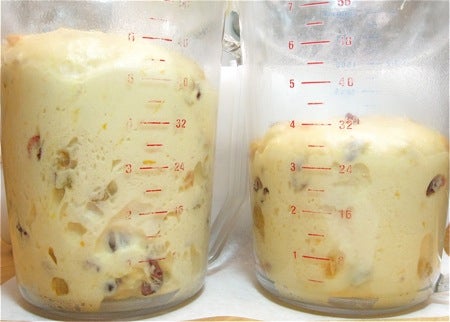
I did an experiment with this bread, using two types of yeast.
On the left, sweet dough raised with Yeast A. On the right, sweet dough raised with Yeast B. Same amount of time. Looks like about a 50% difference in rise, doesn't it?
Clearly, Yeast A is the winner. Meet your new best friend for sweet breads:
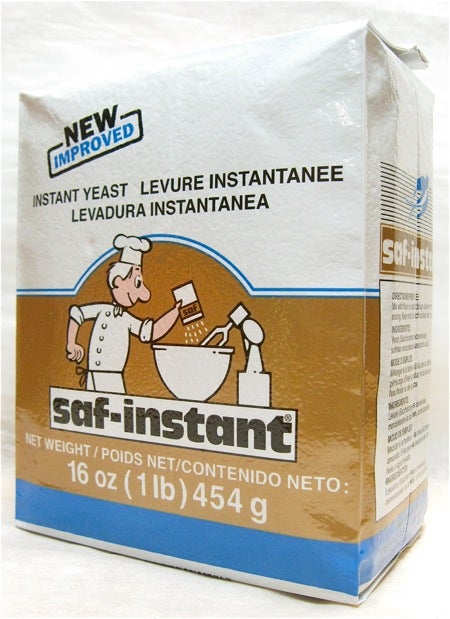
While SAF Red is our favorite all-purpose instant yeast, SAF Gold is an “osmotolerant” yeast, perfect for sweet breads, and any dough with a high amount of sugar. SAF Gold works best when the amount of sugar is between 10% and 30% of the amount of the flour, by weight (this is called a “baker’s percentage”).
So, for a 3-cup-flour loaf (12 ¾ ounces flour), you’d choose SAF Gold if the sugar is greater than 3 tablespoons, or up to about a heaping ½ cup. (Understand that the greater the amount of sugar, the more slowly your dough will rise – even with SAF Gold.)
How does SAF Gold work? Sugar likes to absorb water; and when sugar’s in bread dough, it pulls water away from yeast, leaving the yeast thirsty. The yeast cells in SAF Gold are bred to require less liquid to function; so they’re better able to withstand sugar’s greedy ways with water.
Be advised, though; SAF Gold isn't an all-purpose yeast. It's best used in sweet breads, and won’t do well in “lean” doughs (low in sugar and fat).
And now, back to our Colomba.

Add the following to the bubbly starter in the bowl:
2 1/4 cups King Arthur Unbleached All-Purpose Flour
1 1/4 teaspoons salt
1 tablespoon SAF Gold instant yeast, or instant yeast
1/3 cup granulated sugar
4 tablespoons butter, at room temperature
2 large eggs + 1 large egg yolk, white reserved for topping; room temperature preferred
1/8 teaspoon Fiori Di Sicilia; or 2 teaspoons vanilla extract +1/8 teaspoon orange oil
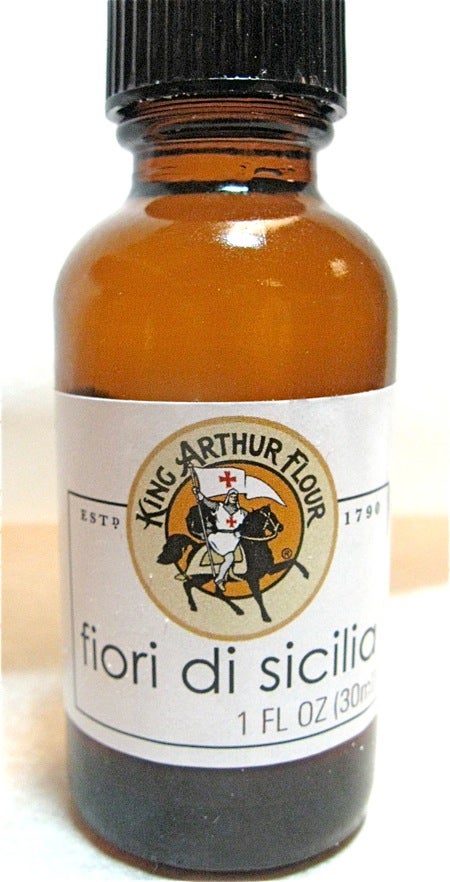
Now, here's a secret ingredient if ever there was one: Fiori di Sicilia, "flowers of Sicily." This orange-vanilla flavor is traditionally used in Italian sweet breads like panettone, as well as this Colomba.
We like to use it in cookies, icing, and pastry fillings, too. It's a great all-around flavor, sure to elicit questions: "Why does this taste SOOOO good?"

1/8 teaspoon Fiori is all you need.

Mix to combine.

Switch to the dough hook, and knead for about 12 minutes at medium speed, stopping the mixer every 3 minutes to scrape the bottom and sides of the bowl.

By the end of the kneading time, the dough should have become elastic and satiny. It should be starting to leave the bottom and sides of the bowl, though it won't form a smooth ball.

Next, we'll add the grated rind of 1 orange. Large orange? Small orange? Depends how much you like orange flavor.
Don't like it? Leave it out. But if you choose to add orange rind, a microplane grater is a superior tool for grating citrus rind (among other things) quickly and easily.
Now, the dried fruit.
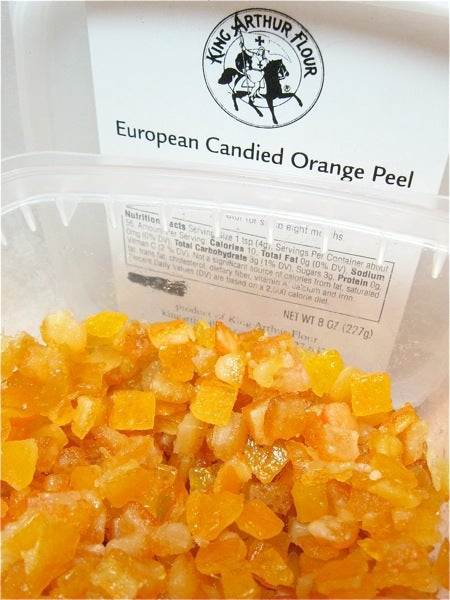
A classic Colomba calls for candied orange peel.
You can certainly use that if you like it; but we find most readers prefer more familiar dried fruits.

Our favorite fruit blend, packed with diced apricots, golden raisins, pineapple cubes, chopped dates, and sweetened cranberries, is colorful and tasty.

Tropical fruit blend, with dried pineapple, papaya, mango, and big flakes of lightly toasted coconut, is a lighter-colored mixture.
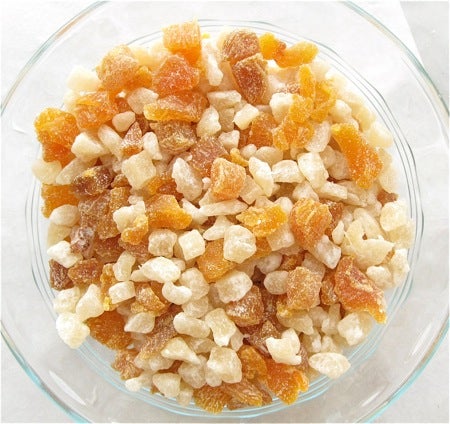
For Colomba, I first chose our favorite fruit blend; then, on the next go-around, tried this mixture of dried apricot and pineapple bits.
Whatever you choose, use a total of 1 cup dried fruit (or candied peel), kneading it into the dough along with the grated orange rind.
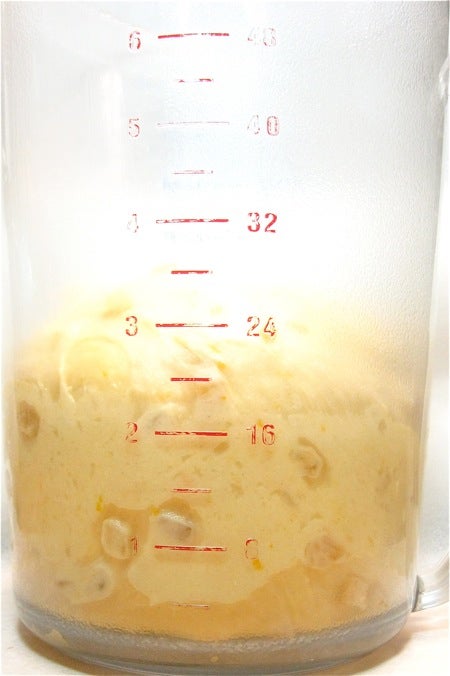
Place the dough in a lightly greased bowl, or an 8-cup measure, as I do here; the measuring cup helps you track the dough's rise.
Cover the bowl or cup, and let the dough rise for 2 hours (3 hours if you're not using SAF Gold yeast).

It should have become quite puffy.

Gently deflate the dough, and divide it in two pieces, one slightly larger than the other.
Shape the larger one into a 10" log, with one tapered end; and the smaller one into a 7" log.

Place the longest log lengthwise on a lightly greased or parchment-lined baking sheet; use the edge of your hand to form a crease in the center.
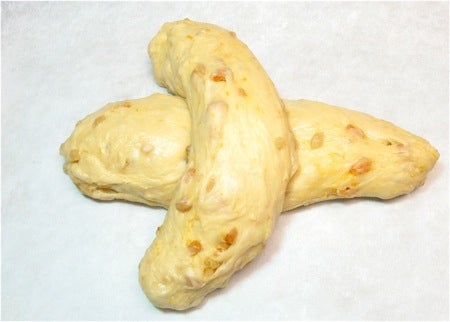
Lay the shorter log crosswise across it, right at the crease. Shape the shorter log into "wings" by pulling it into a crescent shape. (We know, this doesn't really look too awfully much like a dove; think of it as a symbolic representation!)

Flatten out the "wing tips," and the "tail."

Use a pair of scissors to snip "feathers."
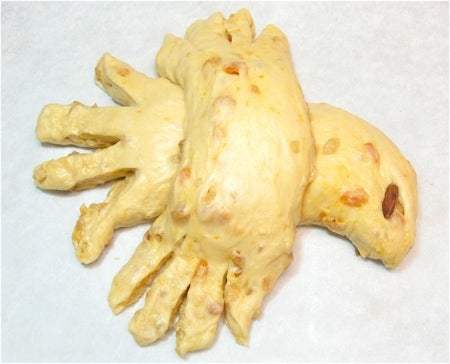
Like this. Add a whole almond for the dove's eye.
Cover the shaped loaf with a cover or lightly greased plastic wrap, and set it aside to rise until it's puffy; this will take about 1 to 2 hours, depending on what type of yeast you've used.
Towards the end of the rising time, preheat the oven to 375°F.

Here we are, about an hour later. You don't want to let the dove rise TOO much; it's going to lose its shape enough as it bakes, without letting it get too puffy prior to baking.
Next: Colomba's classic topping.

For a traditional topping, you'll need both coarse pearl sugar (left), and some kind of almonds (right). It doesn't really matter what kind, since you'll be grinding them.
Don't have pearl sugar? Use coarse white sparkling sugar; or Demerara; or just granulated sugar, though you'll lose "the look."

Prior to adding the sugar topping, you'll brush the loaf with glaze. Mix the following:
1 large egg white, reserved from the dough
3 tablespoons almond flour or toasted almond flour; or 3 tablespoons blanched sliced (or slivered, or unblanched sliced, or whole) almonds, finely ground
2 tablespoons granulated sugar

You'll have a thick glaze.

Brush the risen loaf with the glaze. Be generous; there's plenty to go around.
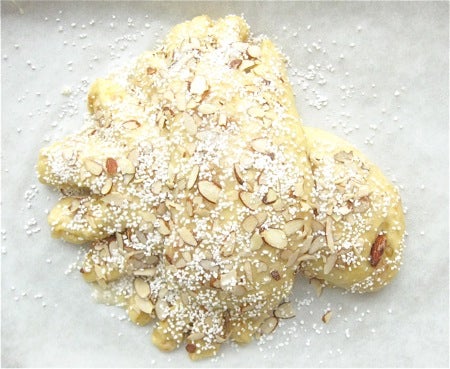
Sprinkle with 5 to 6 tablespoons coarse sugar, and 2 to 3 tablespoons sliced almonds.

Bake the loaf for 15 minutes.

Then reduce the oven heat to 350°F, and bake for an additional 20 minutes...

...tenting it for the final 10 minutes of baking, to prevent over-browning.

Remove the loaf from the oven. It should be golden brown, and an instant-read thermometer inserted into the center should register at least 190°F. Carefully slide the bread onto a rack to cool.
See what I mean about losing its shape? Hey, it's the thought that counts.
And, if you're into dough sculpture, feel free to make your own dove-like design.

Serve in thin slices.
Some enjoy fresh Colomba with a glass of wine; some prefer it toasted, then drizzled with heavy cream or honey, and served with coffee.
It's delicious just plain, too; serve it Easter morning, or later in the day, as a sweet accompaniment to the Easter ham.
By the way, Colomba makes delicious toast. (Be careful of sugar melting into your upright toaster, however; either be prepared for a bit of burnt sugar smell, or toast the dove bread in a toaster oven.)
Read, rate, and review (please) our recipe for Colomba Pasquale.